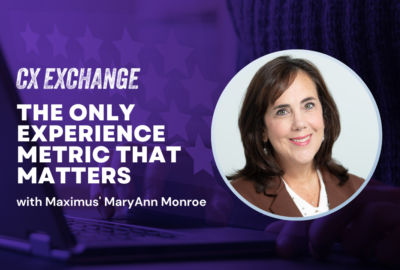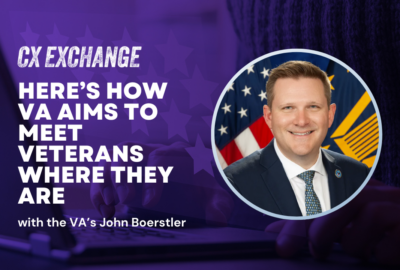CX Exchange 2024: ACF’s Natalie Grant, HUD’s Joe Carter on ‘trauma-informed’ service delivery
ACF, HUD and other agencies collaborate to help make access to services less daunting to people at their most vulnerable and trying to recover from a disaster.
More than 20 million individuals and families survive a federally recognized disaster every year. In the days, weeks and months that follow, people often deal with a tangled web of forms, phone calls and websites to seek federal assistance and begin recovery.
To ease this burden, federal agencies are setting a higher standard for service delivery governmentwide — especially in moments such as these, when individuals are going through a particularly challenging time in their lives.
The Biden administration has identified disaster recovery as one of five “life experiences” that are priority areas for customer service improvement. Each of these life experiences require cross-agency collaboration to ease the public’s ability to find, apply and obtain government benefits and services.
Along with seven other agencies, the Department of Housing and Urban Development and the Department of Health and Human Services are working together to improve the disaster recovery experience, as well as with seven other agencies.
Disasters are a total experience challenge
For both agencies, the focus is end to end — that total experience, involving the person in need of help as well as the employee and agencies aiming to provide those support services.
Joe Carter, HUD’s customer experience strategist, called disaster recovery life experience “one of the best examples of cross-agency collaboration” he’s seen in his 20-plus year career in the federal government.
“It’s enabling us to learn from each other, collaborate with each other, break down siloes in terms of how we improve the experience of the public when they engage across federal agencies,” Carter said during Federal News Network’s CX Exchange 2024. “From the top down, leadership here at HUD is very much focused right now on how we ensure that our staff has the tools, resources and training to deal with not just disaster survivors — because we’re not the front line for handling disaster survivors — but for people that are experiencing homelessness or housing discrimination.”
Natalie Grant, director of the Office of Human Services Emergency Preparedness and Response for HHS’ Administration for Children and Families, said ACF and HUD are “laser-focused” on ways to address post-disaster homelessness.
Grant said both agencies are taking a closer look at each other’s programs and identifying ways to provide complementary services to the public in disaster and non-disaster “steady state” scenarios.
“We identified that there were opportunities for us, through not only program eligibility but also through some of our information-sharing, on how we could ensure that jurisdictions know how best to complement these programs [and] use them together. And then also bringing that conversation to the disaster survivor, so that they know and understand how these pieces connect to give them the best opportunity for success,” Grant said.
Grant added that CX improvement comes from not just listening to other agency partners, but also gathering feedback from the public.
“When we center the individual and their experience, and really understand barriers to access supportive service programs, that’s what we find all the time,” she said. “And in our routine service delivery, taking those lessons and applying them in a post-disaster context, we think, will not only improve the customer experience but lead to better outcomes.”
Understanding emotional aspect of disaster response
Grant said ACF is taking a “trauma-informed” approach to CX delivery. That requires agencies to rethink their outreach to vulnerable and historically impacted communities and understand that each individual attempt to seek federal assistance after a disaster is a make-or-break moment to build trust.
“Part of the post-disaster response environment is about appreciating that communities are not blank slates,” she said. “In taking a trauma-informed approach, we understand that there are certain aspects of community and also of an individual’s experience that may put them in a circumstance where we need to just be more sensitive in terms of how we approach them. We need to understand that our communication styles and also some of our federal documents and application processes may not necessarily resonate with those persons because of their life experiences prior to the disaster.”
Carter said HUD is training its employees on emotional intelligence when customers are in a vulnerable state and going through a crisis. The department is adapting this training from the Federal Emergency Management Agency’s Trauma-Informed Disaster Response Course.
“Oftentimes, when they’re coming to HUD, they’ve had the worst day of their life — or one of the worst days of their life,” Carter said. “Not only do we need to learn how to best provide trauma-informed care to those individuals that are experiencing that hardship, but also it impacts our own employees, and they take that home with them.”
That means taking steps so that HUD employees have the skills and tools they need to maintain their own well-being.
“How do we not only better address the needs of the individuals that are seeking support and help from HUD, but also how do we make sure that our employees don’t burn out — that our employees are able manage the challenges that they face and working with people that are experiencing hardship and are in trauma?” Carter said.
Human-centered design’s role in disaster support services
ACF works with many grantees, nonprofits and governmental agencies that are on the front lines of service delivery following a disaster. To design a better customer experience, ACF has invited disaster survivors to provide feedback on service delivery challenges and opportunities for improvement.
Grant said that improving CX starts with human-centered designed and listening to individuals with firsthand experience trying to obtain federal services following a disaster.
“If I’m telling you that this system or this process is not responsive to my needs, are you making those adjustments? Am I seeing that manifest, in terms of how services are delivered? Am I seeing it manifest in terms of the appeals process, or the eligibility process, the clarity of the information that’s provided — all of those different pieces?” Grant said. “You’re listening to them and then showing them on the back end that, yes, we heard you. These are some of our adjustments made.”
Meanwhile, HUD.gov is going through a major redesign that, in part, aims points customers toward the services they may need most urgently following a disaster —even when those services might be available from another agency.
“We embarked, as part of this effort to do a redesign by listening to our customers — engaging with our partners like FEMA and the Small Business Administration — to better understand their programs so that when they come to HUD.gov, they don’t get lost in all of the information we have about the grants programs that we have for long-term recovery. They can immediately and quickly be redirected to FEMA, the SBA and other resources to get their immediate needs addressed,” Carter said.
SBA, in partnership with HUD, recently launched a burden reduction pilot, to improve the experience of applying for disaster assistance.
“We’re really excited to be a part of that pilot — taking customer journey maps that we have and looking at not just what are the key pain points that customers have, but what are the key burden pain points that they experienced. Because we’re not as efficient as we could be in terms of when they come in and interact with us,” Carter said.
Beyond its disaster recovery portfolio, HUD is also looking to reduce the administrative burden on its customers by enabling income verification data with the Social Security Administration.
“If I’m a member of the public and I have to verify my income for the Social Security Administration, I would hope and quite frankly expect that that I would not have to do so again the next time I engage with another federal program to receive benefits or services,” Carter said. “Tying the income verification work that SSA already is doing and tying their verification to HUD’s processes — so that the customer does it once and only once and doesn’t have to do it multiple times — is another just I think fantastic example of where this work is really leading us to better collaborate and improve how we serve the public to increase trust.”
Discover more customer experience tactics and takeaways from Federal News Network’s CX Exchange 2024 now.
Copyright © 2024 Federal News Network. All rights reserved. This website is not intended for users located within the European Economic Area.
Jory Heckman is a reporter at Federal News Network covering U.S. Postal Service, IRS, big data and technology issues.
Follow @jheckmanWFED






